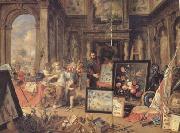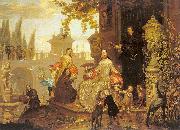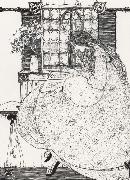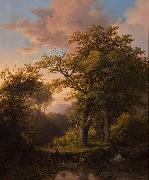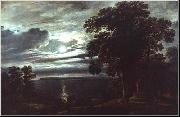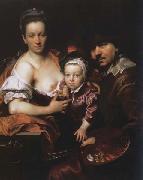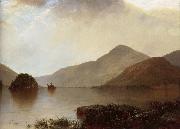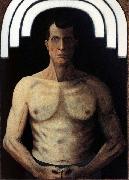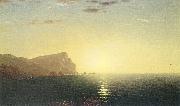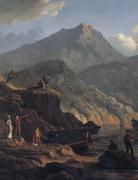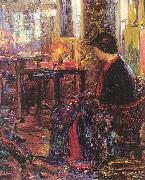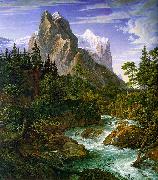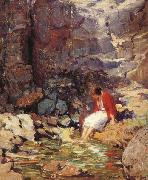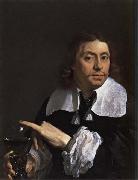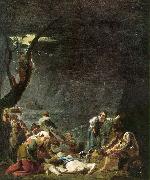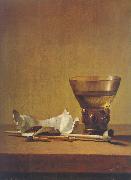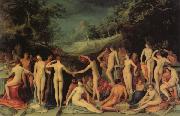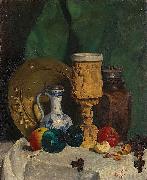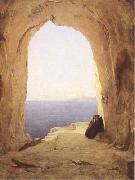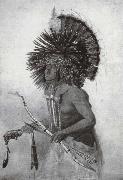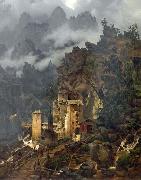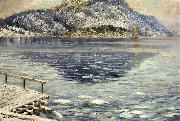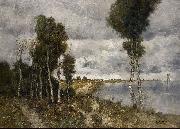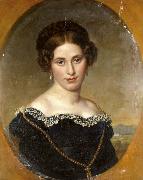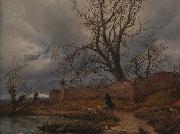|
|
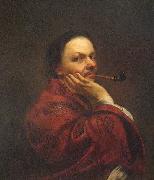 |
Jan Kupecky
|
|
(in German: Johann Kupetzky, in Hungarian: Kupecky Jenos, or Kupeczky Jenos, 1667, Bazin, Royal Hungary (today Slovakia) - 1740, Nernberg, Germany) was a Czech and Slovak portrait painter during the baroque. He was active in Hungary, Slovakia, Vienna and Nernberg.
Kupecký, like many people at that time, was the son of Protestant (Czech Brethren) parents from the Czech lands (Mlade Boleslav) who sought refuge in Slovakia (constituting the core of Royal Hungary at that time) from religious persecution by the Catholics. He was born in Pezinok - a town near Bratislava.
According to the sources he began his studies with the Swiss painter Benedikt Klaus, who was active in both Vienna and in Royal Hungary. At the age of twenty, Kupecký went on a long Italian study trip. In Rome Prince Aleksander Benedykt Sobieski, the son of the Polish king John III Sobieski, helped him to become famous. He returned to Vienna in 1709, after twenty-two years spent in Venice and Rome. We know very little of his Italian activity as well as his early works and his setting in Vienna.
According to his contemporary biographer, the Swiss Johann Caspar Fessli, the Protestant Kupecký, who faithfully clung to his ancestor's religion, remained withdrawn and isolated in Vienna's Catholic milieu, which was under the influence of the court and the aristocracy. However this concept is partly contradicted by the fact that the master had significant courtly commissions while working in Vienna. He painted portraits of various members of the dynasty, Prince Eugene of Savoy, several aristocrats, and, in Karlovy Vary, even of the Russian Czar Peter I. The rich ceuvre of this period comprises a series of gorgeous portraits of Kupecky's family, friends and the painter himself, as well as several persons, whose identity in unknown.
In 1733 Kupecký, fearing religious persecution, fled from Vienna to Nernberg with his family and worked there until his death in 1740. As the most significant portrait painter of contemporary Germany, he was commissioned by a large number of German princes, church dignitaries rich merchants and scholars, and his works were popularized by engravings even during his lifetime. Through his pupils and followers Kupecký's influence and artistic example remained alive and widespread for a long time.
|
|
|
|
|
|
|
|
|
|
 |
johan krouthen
|
|
född 2 november 1858, död i december 1932, var en svensk idealistisk konstnär.
Krouth??n föddes i Linköping och var son till handlaren Conrad Krouth??n och Hilda Åberg. Släkten Krouth??n kom från Norrköping och flera generationer hade arbetat som tenngjutare. Familjenamnet Krut ändrades genom att varubeteckningen Krut-tenn förfranskades till Krouth??n. Conrad Krouth??n kom till Linköping 1850 och startade en manufakturaffär vid Stora torget. Affären gick bra och 1857 kunde han gifta sig med sömmerskan Hilda Åberg.
Krouth??n kunde växa upp i ett välmående hem och han fick börja skolan på läroverket i Linköping. Vid 14 års ålder slutade han skolan och började arbeta åt fotografen och målaren Svante Leonard Rydholm som hade en atelj?? vid St. Larsplan. Krouth??n fick lära sig grunderna i både målning och fotografering och vid 16 års ålder började han på Konstakademiens principskola i Stockholm 1875. Den treåriga utbildningen innebar att eleverna fick lära sig att rita av klot och profiler, djur och växter. Efter de tre åren fick Krouth??n fortsätta vid akademin. I kursen "Lägre antiken" fick eleverna rita av gipsmodeller, i "Högre antiken" teckna efter levande model och i "Landskapsskolan" fick eleverna måla landskap. Under studietiden sökte sig många elever utanför skolan och Krouth??n lärde känna konstnären Edvard Pers??us. Perseus var kritisk till utbildningen på akademin och tog med sina elever bland annat till Mariefred och Gripsholms slott för att måla av naturen. |
|
|
|
|
|
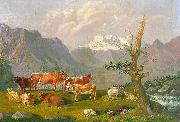 |
Johann Kaspar Scherrer
|
|
painted Weidelandschaft in den Schweizer Bergen mit Katarakt und Gebirgshorizont in 1739 - 1806 |
|
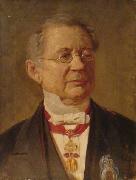 |
Johann Koler
|
|
(8 March 1826, in Vastemõisa near Suure-Jaani, Viljandi County, Estonia - 22 April 1899 in St. Petersburg, Russia) was an Estonian painter. He is considered to have been the first professional Estonian painter. He distinguished himself primarily by his portraiture and to a lesser extent by his landscape paintings. Some of his most notable pictures depict the Estonian rural life in the second half of the 19th Century.
Johann Köler was the seventh child born to a peasant family. Despite the poverty of the parents Köler managed to attend the elementary and the district schools in Viljandi. Then he attended a workshop of master painters in Cesis (then in Livonia).
In 1846, Köler travelled to St. Petersburg to work as a sign writer, where his talent was soon discovered. From 1848 to 1855 Johan Köler studied drawing and painting at the St. Petersburg Imperial Academy of Arts.
During 1857 Köler travelled to Paris via Berlin, later returned to Germany then travelled to the Netherlands and Belgium. In 1858, he travelled across the Alps to Milan, Geneva, Florence and Rome. There, he studied in a private academy and devoted his time to watercolor technique. In Rome during 1859 he presented his composition "Christ on the Cross".
Answering the call of the St. Petersburg Academy of Arts, Köler returned to the city in 1861. From 1862 to 1874 he was a teacher of the Grand Duchess Maria Aleksandrovna, the daughter of Czar Alexander II of Russia. In 1869-1870, he worked as a lecturer at the St. Petersburg Academy of Arts. From 1886 to 1889 Johan Köler worked in Vienna, Nice and Paris. |
|
|
|
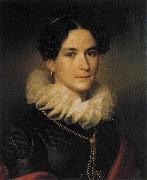 |
Johann Peter Krafft
|
|
(15 September 1780 - 28 October 1856) was a German-Austrian painter.
Krafft was born in Hanau, Hesse. At the age of ten, he began his art studies at the Hanau Akademie. In 1799, he moved to Vienna and studied at the Academy of Fine Arts for three years under the tutelage of Heinrich Feger. From 1802 to 1808, he studied in Paris, with Jacques-Louis David and François Gerard, and then in Rome. On his return to Vienna, he became a successful professional painter, producing numerous portraits.
In 1828, Krafft became director of the Imperial and Royal Picture Gallery in Belvedere Palace.
Johann Peter Krafft died at the age of 76 in Vienna, where he was buried at the Zentralfriedhof. |
|
|
|
|
|
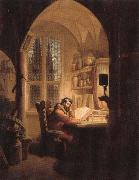 |
john keats
|
|
Born: 31 October 1795
Birthplace: Near London, England
Died: 23 February 1821 (tuberculosis)
Best Known As: Romantic poet who wrote "Ode to a Nightingale"
|
|
|
|
|
|
|
|
|
|
|
|
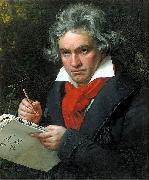 |
Joseph Karl Stieler
|
|
(1 November 1781 - 9 April 1858) was a German painter. Born in Mainz to a family of engravers and die-cutters, Stieler received some artistic training from his father, August Friedrich Stieler (1736 - 1789). Stieler began his career as a painter of miniatures.
His portrait style was most especially shaped during his work in the Parisian atelier of Francois Gerard, a student of Jacques-Louis David. In 1808, he established himself as an independent portraitist in Frankfurt am Main. He traveled through Italy in 1810. In 1816, he traveled to Vienna to paint the portrait of Emperor Francis I of Austria. Between February and April 1820, he worked on his portrait of Beethoven, which is probably the most well-known representation of the composer today.
Stieler worked mainly in the service of the Bavarian court. His painted likenesses in Schloss Nymphenburg, Schönheitengalerie, the so-called Gallery of Beauties, were commissioned by King Ludwig I. Stieler also painted the portraits of Goethe, Amalia of Greece, Friedrich Wilhelm Joseph von Schelling, Johann Ludwig Tieck, and Alexander von Humboldt.
The most distinguishing feature of Stieler's portraits is his utter focus on the sitter. Decorative additions are left out, and there is nothing that distracts the viewer's scrutiny. Stieler accomplished this concentration through deliberate light - dark contrast, which above all highlights the accurately characterized facial features.
He died in Loytown.
|
|
|
|
|
|
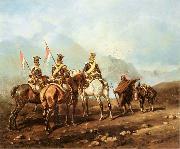 |
Juliusz Kossak
|
|
(Nowy Wiśnicz, 15 December 1824 - 3 February 1899, Krakew) was a Polish historical painter and master illustrator who specialized in battle scenes, military portraits and horses. He was the progenitor of an artistic family that spanned four generations. father of painter Wojciech Kossak and grandfather of painter Jerzy Kossak.
Juliusz Kossak grew up in Lwew during the military partitions of Poland. He obtained a degree in law at the Lwew University encouraged by his mother. At the same time he studied painting with Jan Maszkowski and Piotr Michałowski. Beginning in 1844 Kossak worked on commissions for the local aristocracy in Malopolska, Podolia and Wolyn. He married Zofia Gałczyka in 1855 and together they left for Paris where they spent five years. His sons were born there, the twin brothers: Wojciech and Tadeusz (on New Year's Eve 1856-1857) and the younger Stefan in 1858. The family came to Warsaw in 1860 where Kossak obtained a position as the head illustrator and engraver for Tygodnik Illustrowany magazine. They moved to Munich for a year and in 1868 settled in Krakew blessed with five children already. Kossak bought a small estate there, known as Kossakewka, famed for artistic and literary salon frequented by Adam Asnyk, Henryk Sienkiewicz, Stanisław Witkiewicz, Jezef Chełmoki and many others. Juliusz Kossak lived and worked there till the end of his life. In 1880 he was awarded the Cross of Order of Merit by Emperor Franz Joseph of Austria-Hungary for his lifetime achievements as an artist.
|
|
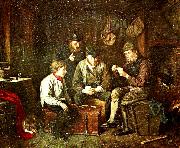 |
k. e. jansson
|
|
Karl Emanuel Jansson, född 7 juli 1846 i Finström, Åland, död 1 juni 1874 i Jomala, var en åländsk konstnär. Han var näst äldst av sju syskon. Han far, Jan Jansson, var en bonde i Pålsböle.
Sina konstnärliga inspiration fick han av sockenmålaren G Kjellgren, vid sex-sju års ålder, när han där lärde sig att läsa och skriva. Efter avlutad skolgång sattes han i skomakarlära. Efter ett år drogs han till Kjellgren och fungerade som hans hjälpreda. Kyrkoherden Frans von Knorring såg i slutet av 1859 några av hans teckningar. Han sände några till Finska Konstföreningens direktion och lovordade Karl.
Förening gav ett bidrag för att kunna studera vid Finska Konstföreningens ritskola i Åbo, under ledning av Robert Wilhelm Ekman. Av Ekman fick han husrum, rit- och målningsmaterial och en hel del extra undervisning. Karl gjorde stora framsteg under de 2 åren han målade med Ekman.
Jansson flyttade hösten 1862 till Stockholm, för att kunna utvecklas mer som artist, och inskrevs som elev vid Kongl. Akademin för de fria konsterna. Han tog anatomiexamen 1863. Han levde under svåra ekonomiska förhållanden och hade svårt att sälja sina verk.
Jansson fick hård kritik för de målningar han sände hem, exempelvis, Babian ätande en råtta, och konstföreningen betraktade dem med avsky. Han började då kritisera sig själv allt mer och mer, och den inställningen behöll han. Han fick inte den uppmärksammad han behövde. Tavlan Den förlorade sonens återkomst, belönades med ett pris. Han avslutade sin utbildning vid akademien 1867 med mycket beröm. Jansson lyckades utverka statsstöd för studier i Dusseldorf och reste dit på hösten 1868. Han åkte hem igen sommaren 1870 och tillbringade ett år på Åland innan han återvände till Dusseldorf.
Han var nu märkt av en tilltagande lungsjukdom. De sista verk han fullbordade var Talmannen och En slant i håven. För att lindra sin sjukdom reste han till Rom i mars 1872. Efter några månader åkte han runt till olika kurorter (Davos, Meran) men inget förbättrade hans tillstånd. Efter en liten tid i D??sseldorf kom han hem till Åland sensommaren 1873.
Karl flyttade in på Jomala gård, där lagman Lönnblad och hans fru tog hand om honom. Han målade några verk, vilka blev ofullbordade. På dödsbädden fick han veta att han belönats på världsutställningen i Wien för sina konstverk Klöveress och Talmannen, samt att han blivit medlem i konstakademin i Sankt Petersburg. Han dog 1 juni 1874, inte ens fylld 28 år. |
|
|
|
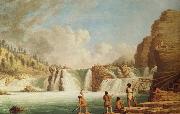 |
Kane Paul
|
|
Irish-born Canadian Painter
b.1810 d.1871
|
|
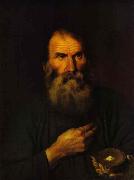 |
Kapiton Zelentsov
|
|
Kapiton Zelentsov (Russian 1790-1845) was a Russian painter notable for his illustrations for books by Aleksandr Pushkin, Faddei Bulgarin and Mikhail Zagoskin. He was the student of Alexey Venetsianov.
|
|
|
|
|
|
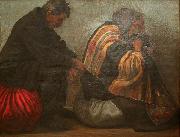 |
Karel Myslbek
|
|
Karel Myslbek (1874-1915)Aliases: Frant. VovesProfessions: Figure painter; Painter. |
|
 |
Karel Purkyne
|
|
(1834-1868) was a Czech painter. He was one of the most prominent proponents of realism in Czech art in the second half of the 19th century. He was the son of the physiologist and anatomist Jan Evangelista Purkyne, and developed an interest in art while still young. Early influences included the Baroque painters Karel Škreta and Petr Brandl and the paintings of the Dutch Golden Age. He spent a year in Munich studying with Johann Baptist Berdelle before traveling to Paris, where he worked with Thomas Couture; there he copied paintings by Old Masters and encountered the work of contemporary French artists. He was particularly struck by the works of Gustave Courbet. Upon returning to Prague, Purkyne became known primarily as a portraitist, though a handful of works in other genres are known. He also made a name for himself as an organizer of artistic events and as an art critic.
|
|
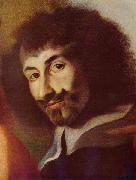 |
Karel skreta
|
|
(1610, Prague - July 30, 1674, Prague) was a Czech Baroque painter.
Karel learnt painting perhaps from one of the masters at the royal courtyard. He studied in Saxony and in Italy. According to Houbraken he painted portraits and lived together with the respected watercolor painter Willem Bouwer in Rome. He became a member of the Bentvueghels with the nickname Slagzwaart or Slach-sweerd.According to the RKD he was the teacher of the Prague painter Johann Georg Heinsch (1640-1713).
Since 1638 he lived in Prague, where he worked on altarpieces for many churches, for example St. Thomas, St. Stephen or the Church of Our Lady in front of Týn.
|
|
|
|
|
|
|
|
|
|
|
|
|
|
|
|
|
|
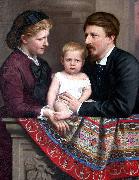 |
Karl Ernst Papf
|
|
Karl Ernest Papf (Dresden, Germany, 1833 -Sao Paulo, 1910) was a German painter, and draftsman that moved to Brazil in 1867.
He studied in the Academy of Fine Arts of Dresden and in 1867, was hired for the profession of photographer by the firm of his compatriot Albert Henschel. He initially worked in Recife until 1872, then in Salvador until 1877 - always in service of the atelier Albert Henschel & Cia., as written in Almanak Laemmert. He moved to Rio de Janeiro in surch for a better environment for the development of his work. |
|
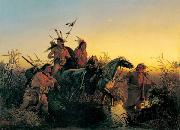 |
Karl Ferdinand Wimar
|
|
(also known as Charles Wimar and Carl Wimar) (1828-1862), was a German-American painter who concentrated on Native Americans in the West and the great herds of buffalo.
He is known for an early painting of a colonial incident: his The Abduction of Boone's Daughter by the Indians (1855-1856), a depiction of the 1776 capture near Boonesborough, Kentucky of Jemima Boone and two other girls by a Cherokee-Shawnee raiding party.
|
|
|
|
|
|
|
|
|
|
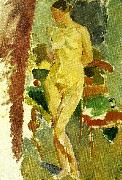 |
karl isakson
|
|
Karl Isakson, född 1878, död 1922, konstnär.
Karl Isakson växte upp i Stockholm, han och systern Ester uppfostrades av en religiös ensamstående mor, då fadern tidigt gått bort. |
|
|
|
|
|
|








